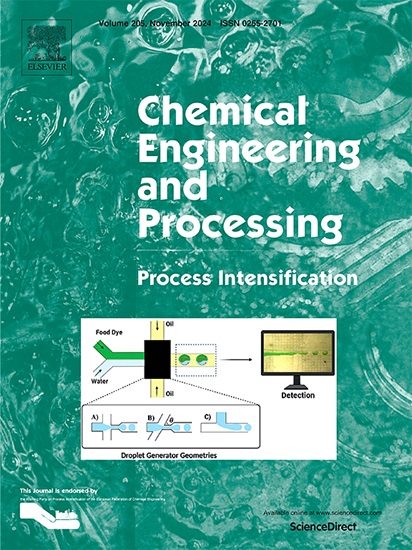Reaction/distillation matrix algorithm development to cover sequences containing reactive dividing wall column: Validation in process of cumene production
IF 3.8
3区 工程技术
Q3 ENERGY & FUELS
Chemical Engineering and Processing - Process Intensification
Pub Date : 2025-03-30
DOI:10.1016/j.cep.2025.110289
引用次数: 0
Abstract
The Reactive Dividing Wall Column (RDWC) offers a powerful approach to process intensification by combining chemical reactions and multi-component separations within a single unit, delivering significant economic and operational benefits. This study investigates various RDWC configurations for Cumene production generated through a modified Reaction/Distillation matrix-based algorithm. Rigorous simulations of both the conventional Reactive Distillation Column (RDC) and RDWC setups were conducted in Aspen Plus, while the Teaching-Learning-Based Optimization (TLBO) algorithm in MATLAB minimized total annual costs (TAC) and met product specifications. TLBO was chosen for its parameter-free nature, computational efficiency, and strong optimization performance, making it a robust tool for this case study. Comparative analysis revealed that the optimized RDWC configuration substantially outperformed the conventional RDC, reducing TAC by 27.62 % and total energy consumption by 27.98 %. Furthermore, the optimized RDWC configuration led to a 57.66 % decrease in capital costs and a 29.13 % reduction in operating costs by minimizing the required number of columns, condensers, and reboilers. These results demonstrate that the RDWC is a highly efficient and economically viable option for energy-intensive processes such as Cumene production, achieving substantial cost savings and enhanced operational efficiency.

反应/蒸馏矩阵算法的发展,以涵盖含有反应性分壁柱的序列:异丙烯生产过程中的验证
反应性分壁柱(RDWC)通过在单个装置内结合化学反应和多组分分离,提供了一种强大的过程强化方法,具有显著的经济和操作效益。本研究通过改进的基于反应/蒸馏矩阵的算法,研究了不同的RDWC配置,以生产异丙苯。在Aspen Plus中对传统的反应精馏塔(RDC)和RDWC装置进行了严格的模拟,而MATLAB中的基于教学的优化(TLBO)算法最小化了总年成本(TAC)并满足了产品规格。选择TLBO是因为其无参数特性、计算效率和强大的优化性能,使其成为本案例研究的可靠工具。对比分析表明,优化后的RDWC配置大大优于传统RDC, TAC降低27.62%,总能耗降低27.98%。此外,优化后的RDWC配置通过减少所需的塔、冷凝器和再沸器的数量,使资本成本降低了57.66%,运营成本降低了29.13%。这些结果表明,RDWC对于能源密集型工艺(如Cumene生产)来说是一种高效且经济可行的选择,可以大幅节省成本并提高运营效率。
本文章由计算机程序翻译,如有差异,请以英文原文为准。
求助全文
约1分钟内获得全文
求助全文
来源期刊
CiteScore
7.80
自引率
9.30%
发文量
408
审稿时长
49 days
期刊介绍:
Chemical Engineering and Processing: Process Intensification is intended for practicing researchers in industry and academia, working in the field of Process Engineering and related to the subject of Process Intensification.Articles published in the Journal demonstrate how novel discoveries, developments and theories in the field of Process Engineering and in particular Process Intensification may be used for analysis and design of innovative equipment and processing methods with substantially improved sustainability, efficiency and environmental performance.

 求助内容:
求助内容: 应助结果提醒方式:
应助结果提醒方式:


